Artifacts from Alsager Mere
Artifacts Recovered from Alsager Mere
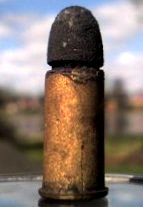 Bucket Dredging
Bucket Dredging
Using a dredge made from a welded steel cage, many items were discovered. One of which was a live, unfired bullet!
Magnetic Dredging
Super strong magnets known as rare earth magnets can be used to find any ferrous (Iron like) materials. Only small magnets have been used so far, but these are able to separate small particles from the lake bed. It takes little effort to collect a sample, therefore showing that there is quite a reasonable presence of iron in the sediment. In the near future a much larger magnet will be used in an attempt to recover or locate larger objects.
Artifacts
If you have any information on the artifacts in this section, or would like a higher resolution image, please contact us.
Unfired Bullet
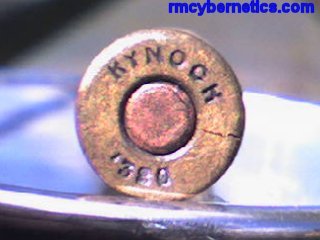 This is the base of the bullet shown above. The text on the bullet says “KYNOCH .380”
This is the base of the bullet shown above. The text on the bullet says “KYNOCH .380”
The cartridge is a .380 Revolver (Short) with an outside-lubricated bullet of up to .376” diameter.
It was loaded with 10 grs. Black powder or 3 grs. Smokeless powder with a 124gr. Lead, Solid or Hollow-point bullet and produced a muzzle velocity of around 1050 fps.
This type of cartridge was produced in great numbers from the early 1870’s and production ceased in the 1950’s. It was used in single shot rifles, pistols and revolvers and was only suitable for short-range target and small game use.
Information provided by Kynamco
Old Pocket Watch
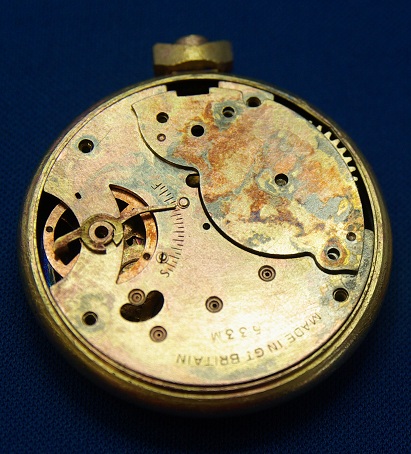 This watch was found in summer 2011 after raking out the weeds for fishing. It was in terrible condition and looked little more than a muddy rock. It had been in the water for some time and all but the brass parts were missing or corroded away. The only markings on it say “MADE IN GT BRITAIN 533M”. The way the markings are stamped indicate that is probably less than 100 years old.
This watch was found in summer 2011 after raking out the weeds for fishing. It was in terrible condition and looked little more than a muddy rock. It had been in the water for some time and all but the brass parts were missing or corroded away. The only markings on it say “MADE IN GT BRITAIN 533M”. The way the markings are stamped indicate that is probably less than 100 years old.

Beer Mug, Jar, and Earthenware Pot
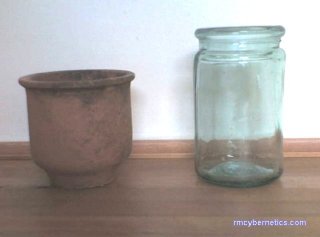 The pot on the left has a clear glaze on the inside, but it has not been neatly applied. This suggests that it was made purely for its intended function and not as an ornament. The pot would seem to be of a utilitarian earthenware type, produced widely throughout Europe since the medieval period. It is therefore impossible to suggest a manufacturer or date, although it is probably of local origin.
The pot on the left has a clear glaze on the inside, but it has not been neatly applied. This suggests that it was made purely for its intended function and not as an ornament. The pot would seem to be of a utilitarian earthenware type, produced widely throughout Europe since the medieval period. It is therefore impossible to suggest a manufacturer or date, although it is probably of local origin.
 This object is a mug, possibly for beer or ale, of a type popular during the 19th century. Again the piece may be of local origin, but we are unable to identify the manufacturer or date.
This object is a mug, possibly for beer or ale, of a type popular during the 19th century. Again the piece may be of local origin, but we are unable to identify the manufacturer or date.
With info from The Potteries Museum & Art Gallery
Decorative Mug
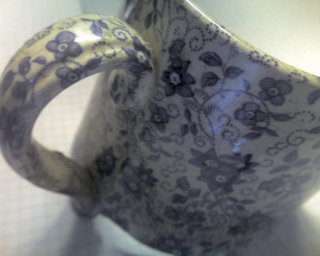 This part of a mug is typical of the many pottery fragments that can be found in Alsager Mere.
This part of a mug is typical of the many pottery fragments that can be found in Alsager Mere.
You can see how the pattern extends around the rim to the inside of the mug.
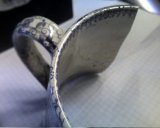
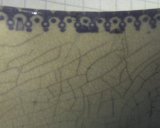
Glass Bottles
 These are various bottles found in and around Alsager Mere. The object shown on the left has a rounded base (or top?) and eight flat sides. The rest of it is missing, which makes it hard to tell what it was used for.
These are various bottles found in and around Alsager Mere. The object shown on the left has a rounded base (or top?) and eight flat sides. The rest of it is missing, which makes it hard to tell what it was used for.
Marmalade Jar
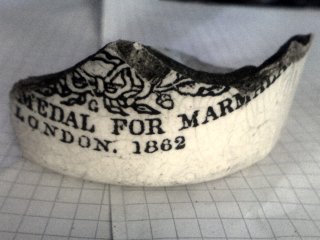 This is a small part of an antique marmalade container. Fortunately the remaining text gives us most of the important information. It says “MEDAL FOR MARMALADE” – “LONDON. 1862”
This is a small part of an antique marmalade container. Fortunately the remaining text gives us most of the important information. It says “MEDAL FOR MARMALADE” – “LONDON. 1862”
On the base the remaining part of the stamp shows a letter K in a circle and has the word “NEWCASTLE”
?Unidentified Object?
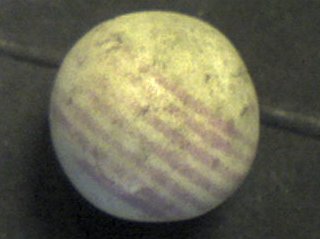 This object is a small ceramic ball with an average diameter of 15mm. It seems to be hand made as it is not perfectly round. The age and purpose of this artifact are unknown at this time.
This object is a small ceramic ball with an average diameter of 15mm. It seems to be hand made as it is not perfectly round. The age and purpose of this artifact are unknown at this time.
 There are seven purple parallel lines that go about 90% around the ball. These lines are either faded or were not painted around the entirety of the ball.
There are seven purple parallel lines that go about 90% around the ball. These lines are either faded or were not painted around the entirety of the ball.
If you have any idea what this object is please contact us or post a comment below.
Next Page: Wildlife of Alsager Mere
Previous Page: Depth Maps of Alsager Mere
19 Comments
Leave a Reply
You must be logged in to post a comment.

Hello. The small ceramic sphere about 15mm in diameter recovered from Alsager Mere is almost certainly a child’s marble: probably late C19 or early C20. When excavating a Victorian school playground here in York we found numbers of them in the drains! Yours is unusual in that it is marked or decorated. Best wishes Colin (archaeologist)
The ball in the artifacts looks like a grinding ball used in mills to grind ceramic products.v common and used with zircon silica glaze and the like.
Ozzie Pike! That takes me back a bit. “Oscar” was the name given to a legendary giant pike that inhabited the Mere. Apparently un-catchable and the breaker of many anglers’ lines…and hearts. I remember these stories from the late 1960s.
Ozzie Pike?
No sign of the legendary Ozzie Pike?
Hi, in the Matanzas city, in Cuba exist one wiht seven concetric circles also painted with same color. Always has been a mistery. Was found in a archaeological excavation next to aboriginal amerindians human bones, Cyboneys, from Stone Age. In the “Comité Espelológico de Matanzas” (from “Sociedad Espeleológica de Cuba”) is the pieze.
Kind regards,
Georgeos@antiquos.com
My guess on your 15mm ball would be musket shot, there was some experiments done on Mythbusters from memory done with regard to this. I know they did cannon rounds.
Octagonal glass vessel was for mineral waters. Very interesting as this is quite a rare shape. The marmalade base is from a Keiler’s Dundee Marmalade pot and the base notes it as coming from the Malling Factory Newcastle on Tyne

Look lie a ball from a game. Possible an early form of lawn billiards.7 stripes…how mysterious
lol, yes, I’m sure it was
Have you found a wooden chest with gold rusty edging? This chest should be filled with gold and silver coins and was dropped into the deeper part of the Mere.
Tried some dredging with a larger magnet. Collected lots of ferrous (Iron) goop and some bits of wire!
At a later period when musket balls were in demand, but in short supply, they experimented with fired clays.
I guess sometime soon now the weather is warming up. Probably try some further dredging too.
Have you any idea when the larger magnet is going to be used?
Looks like a marble, maybe?
I haven’t seen any, but I’ll post it if I do. Is Barker of some local significance?
have there been found any bottles that said Barker on them?
At a glance, that ball reminds me of a croquet ball, with the stripes on it.